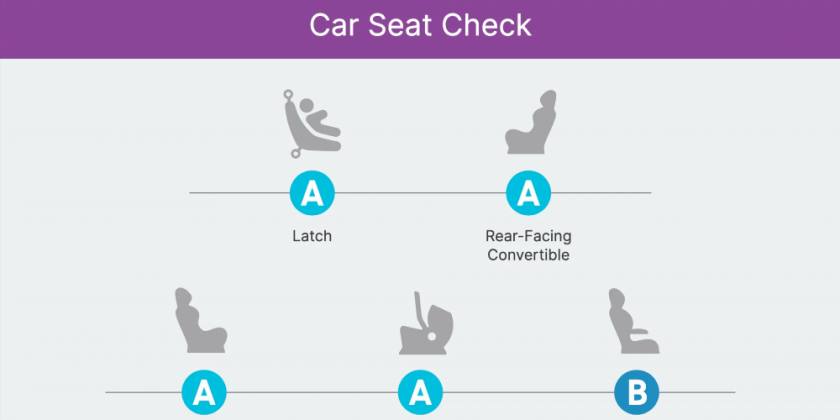The verdict: Honda’s popular Civic compact is available in sedan, coupe and four-door hatchback body styles. For 2020, the Civic hatchback gets updated front and rear styling as well as revised dashboard trim and extra sound insulation. We tested the sedan for this Car Seat Check, which is roomier than it looks. Two car seats fit with ease and our front passenger had enough legroom — even after installing space-hogging, rear-facing car seats.
Does it fit three car seats? No
Take a look at how the Latch system and each car seat scored below in our Car Seat Check of the 2020 Honda Civic sedan.
Related: Search Car Seat Checks
A Grade
- Latch: The two sets of lower anchors are not quite exposed and the seat cushions move easily out of the way for easy access and connection. Three top tether anchors sit on the rear shelf behind fixed head restraints; they sit under flip-up covers stamped with the Latch symbol.
- Infant: Installation was easy and our 5-foot, 6-inch front passenger had comfortable legroom.
- Rear-facing convertible: As with the infant seat, installation was easy and the front passenger had enough legroom.
- Forward-facing convertible: The seat went in easily and fit well. According to the owner’s manual, the top tether strap should be routed over the top of the head restraint. For dual tether straps such as those on our test-car seat, both straps should be routed over the top of the head restraint.
B Grade
- Booster: The booster fits well despite the sedan’s fixed head restaurants, which can sometimes push the booster off the seatback. The buckles are floppy, however, and can fall behind the booster. This can make them tough for kids to grasp and use independently.
C Grade
- None
Grading Scale
A: Plenty of room for the car seat and the child; doesn’t impact driver or front-passenger legroom. Easy to find and connect to Latch and tether anchors. No fit issues involving head restraint or seat contouring. Easy access to the third row.
B: One room, fit or connection issue. Some problems accessing the third row when available.
C: Marginal room plus one fit or connection issue. Difficult to access the third row when available.
D: Insufficient room, plus multiple fit or connection issues.
F: Does not fit or is unsafe.
About Cars.com’s Car Seat Checks
Editors Jennifer Geiger, Jennifer Newman and Matt Schmitz are certified child safety seat installation technicians.
For the Car Seat Check, we use a Graco SnugRide Classic Connect 30 infant-safety seat, a Britax Marathon convertible seat and Graco TurboBooster seat. The front seats are adjusted for a 6-foot driver and a shorter passenger. The three child seats are installed in the second row. The booster seat sits behind the driver’s seat, and the infant and convertible seats are installed behind the front passenger seat.
We also install the forward-facing convertible in the second row’s middle seat with the booster and infant seat in the outboard seats to see if three car seats will fit; a child sitting in the booster seat must be able to reach the seat belt buckle. If there’s a third row, we install the booster seat and a forward-facing convertible. Learn more about how we conduct our Car Seat Checks.
Parents should also remember that they can use the Latch system or a seat belt to install a car seat, and that Latch anchors have a weight limit of 65 pounds, including the weight of the child and the weight of the seat itself.
Cars.com’s Editorial department is your source for automotive news and reviews. In line with Cars.com’s long-standing ethics policy, editors and reviewers don’t accept gifts or free trips from automakers. The Editorial department is independent of Cars.com’s advertising, sales and sponsored content departments.
Source: Read Full Article


